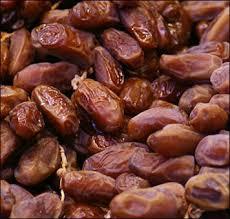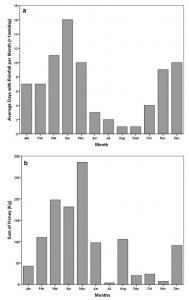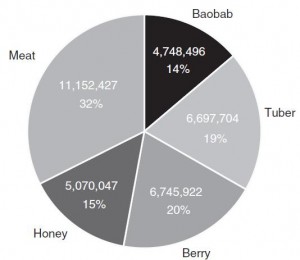From what I gather, it’s been difficult to pinpoint the role of plants in the diet of our ancestors for a variety of reasons. For example, evidence of plants on cooking tools and dental remains is suggestive but doesn’t disprove the possibility that said evidence came from preparing the plants for some other purpose (eg, tools, weapons, or medicine), or that the stomach contents of an herbivore was ingested (which gets partial credit).
That said, after reviewing a few studies on the topic (see below), it’s safe to say that plants were eaten, probably frequently, and the types & quantities varied seasonally & geographically. Collectively, the data suggest we aren’t carnivores.
@CaloriesProper I do wonder why there is so much debate around this? Ancient humans ate plants and animals. The end.
— Jamie Scott (@_Jamie_Scott) July 2, 2014
…you had to have something to hold you over until the next fish fell prey to your deadly hunting spear…
One group of researchers sought evidence of plant consumption on, as mentioned above, [cooking/eating] tools and dental remains ranging from an estimated 10,000 to 130,000 years ago (Henry et al., 2014). More specifically, they were looking for phytoliths (evidence of grasses) and starch granules, and they found significantly less of the former. This led them to conclude that the starch granules likely came from ingesting starch-containing plants directly, rather than from the stomach contents of an herbivore. If the latter were true, they would’ve found more phytoliths because “herbivores consume large quantities of phytolith-rich grasses.” Based on certain physical characteristics of the starch granules and their knowledge of what grew in the area, the authors speculated that the starch granules came from plants of the waterlily family, possibly some grass seeds, and a few others.
@CaloriesProper It almost feels like some want to go “See! H&G’s did eat plants! Therefore Wheaties are back on!” — Jamie Scott (@_Jamie_Scott) July 2, 2014
No, this doesn’t mean Wheaties are back on!
While such a study isn’t capable of determining how much plants contributed to the diet, the authors concluded: “Our results indicate that Middle Paleolithic Neanderthals probably consumed as many plant species as modern humans did.” The phrase “as many plant species” doesn’t indicate how much, but rather how many different types of plants. Qualitative, not quantitative.
Another study sought evidence of plant ingestion by analyzing fecal remains found in Spain, circa 50,000 years ago (Sistiaga et al., 2014). They compared metabolites of cholesterol (from animal foods) to those of phytosterols (from plant foods), on a more quantitative level. Their results showed that while the majority of the diet was likely animal-based in this population, vegetation was not absent, suggesting omnivory as opposed to plant avoidance or frank carnivory.
Lastly, this study focused on the diets of modern hunter-gatherer societies, and showed that when honey is present, seasonally and geographically, it comprises a relatively large proportion of the diet (Marlowe et al., 2014). For example, during the rainy season in the Congo, the Mbuti get up to 80% of their calories from honey.
And in Tanzania, seasonal honey harvesting by the Hadza is proportional to the amount of rainfall:
The rainy season is a time when hunting is less productive and honey is most available. Thus, honey fills an [essential] energetic void… just not 365 days a year.
Given that these groups are still around today, the researchers were able to estimate the relative contribution of various foods to the overall calories (at one point in time):
Conclusion of part 1: there may have been certain times of the year in specific places on Earth when the diet was meat-based, I won’t deny this, but an increasing amount of evidence suggests omnivory predominated.
Part 2.
Are we carnivores that should avoid plants because they’re harmful?
No, that’s ridiculous.
Thirty thousand-year-old evidence of plant food processing (Revedin et al., 2010)
OK, so do we *need* to eat plants? Of course not. Do we *need* to eat meat? Of course not (eg, 1, 2, 3).
You’ll see in the blogosphere that most bloggers have the gist of it – there’s no concrete proof that plants [or meat] is absolutely necessary in the diet… this is nutritional sciences; that’s the nature of the beast. For someone who thinks metabolic syndrome is best treated with a low-fat calorie-restricted diet, I doubt any of my blog posts have changed their opinion… I feel similarly about this issue.
Given my personal bias (which is moar animal protein btw), I feel dirty admitting this, but based strictly on the literature (assuming the bar isn’t set ridiculously low), there are many more studies demonstrating the safety of meat-avoidance (vegetarianism) than that of plant-avoidance (carnivory).
The longest (and one of the only) decent study on human carnivory I know of is Stefansson and Andersen. N=2. They didn’t get scurvy! #winning?
My take: vegetarianism and carnivory are not ‘hedged bets.’ Do you *need* to eat meat or plants? Obviously, you need to eat foods from at least one of the groups. But, need =/= optimization.
adding meat to a vegetarian diet = adding plants to a carnivorous diet ?
Sauteed green leafies, Brussels sprouts, mixed nuts, berries, ‘shrooms, sauerkraut, etc., etc... these are all very nutrient-dense.
Speculation: potential consequences of micronutrient insufficiencies and/or imbalances? maintenance of an elevated level of body fat (role for leptin signaling?) …skeletal muscle protein synthesis and turnover are expensive processes, involving many enzymes and their requisite [micronutrient] cofactors… also, GI problems, mood disorders, etc., etc… maybe I’m over thinking it, but, well, that’s what I do.
Does eating ‘nose-to-tail’ cover all your bases? Place your bets! it may have worked for S&A, but scientific support for this is sorely lacking. Incorporating a variety of plants, cooked & raw, into your diet doesn’t make it a high carb diet! …the few carbs in the plants mentioned above are largely fibre.
And they’re good calories. By that I mean, besides being real food, low in net carbs, and very nutrient-dense, they don’t hijack your appetite. In one study, participants were instructed to add 43 grams (a little under 2 ounces) of almonds to their diet (Tan and Mattes, 2013). This should’ve added about 250 Calories to their total food intake, but the results showed that the calories were completely compensated for, and in some cases, even more so. That is, they participants spontaneously ate less [other stuff]:
Are these foods healthy because they displace something worse? That might be the case for switching from regular soda to diet – wherein almost anything that replaces the calories is an improvement.
Nuts and many other plants aren’t healthy because they’re not high fructose corn syrup, they’re healthy because they’re good calories.
And anyway, carnivory excludes coffee, dark chocolate, and red wine. If that’s paleo, count me out.
For full access to all new articles (or if you just like what I do and want to support it), head over to Patreon! Five bucks a month gets you in and there are many other options. It’s ad-free and you can cancel if it sucks 🙂
For personalized health consulting services -> drlagakos@gmail.com.
UPDATED Affiliate Links: It’s 2018, join Binance and get some damncryptoassets or download Honeyminer and get some Bitcoins for free!
Start your OWN Patreon campaign!
Join Earn.com with this link and get paid to answer questions online.
Still looking for a pair of hot blue blockers? Carbonshade is offering 15% off with the coupon code LAGAKOS and Spectra479 is offering 15% off HERE.
If you have no idea what I’m talking about, read this then this.
20% off some delish stocks and broths from Kettle and Fire HERE.
If you want the benefits of ‘shrooms but don’t like eating them, Real Mushrooms makes great extracts. 10% off with coupon code LAGAKOS. I recommend Lion’s Mane for the brain and Reishi for everything else.
This just in: It is now considered safe for humans to consume plants. STOP THE PRESSES! http://t.co/LJ7APkEYN1
— Gerard Pinzone (@GerardPinzone) July 7, 2014







